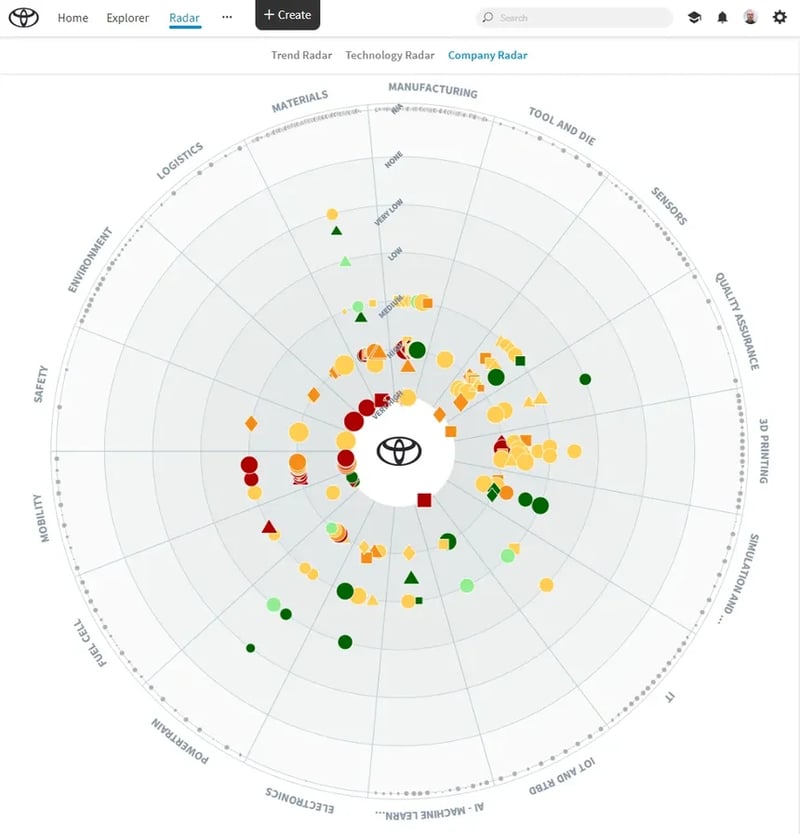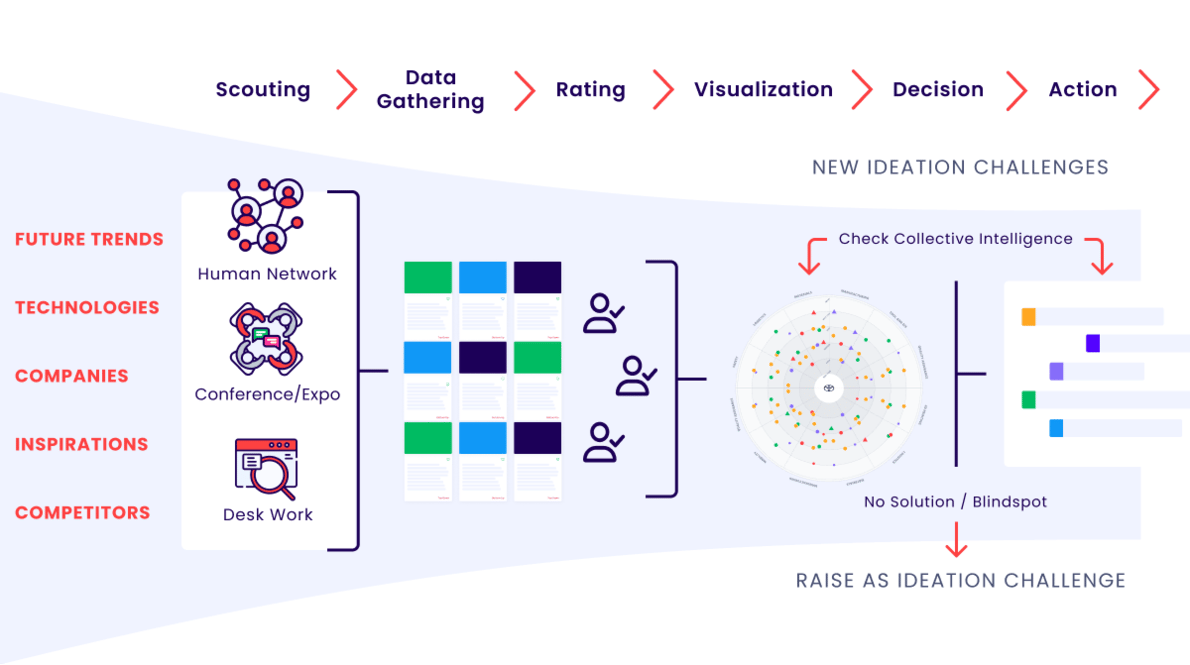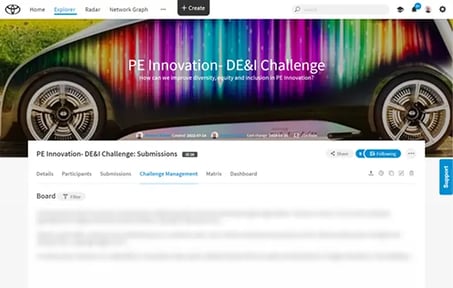Integrating a new software system signifies a profound transformation for organizations, particularly for multi-faceted corporations with numerous business units, divisions, and international offices. Such an extensive task requires the unwavering dedication of empowered innovation management professionals and the sustained commitment of senior management for its successful execution. This article highlights four fundamental learnings derived from Toyota Motor Europe's experience with implementing the ITONICS Innovation Operating System within their organizational framework.
Andrew Willett is a Senior Expert at Toyota, responsible for production innovation and its management across the European region. When Toyota decided to take some load off the Japanese side of the company, Andrew and his team got the opportunity to move innovation closer to the European production, thereby enabling all manufacturing centers to partake in transformational activities.
According to Andrew, innovation is accelerating, and the manufacturing centers wanted to equip their 'members' – as Toyota calls its employees – with the necessary skills to keep up. With several hundred members in the European region actively involved in manufacturing innovation, all with great potential and competence, Toyota wanted to give every individual the opportunity to contribute their sense of novelty and originality. It was during this time that Andrew and his team identified the need for an organization-wide innovation system for all these people to come together.
Today, Toyota Motor Europe has started to centralize research and innovation information on a single platform. This move not only enables comprehensive visibility into metrics throughout the organization, but also facilitates the creation of an innovation pipeline for end-to-end efficiency evaluation.
Read the full success story: Increasing innovation efficiency and impact at Toyota
1. Strive for a single source of truth
In innovation management, data from a variety of sources converge. To coherently aggregate, organize and evaluate this information while avoiding redundancy, innovation practitioners require a central location, accessible anytime and from anywhere. This single, continually updated source of truth fosters increased transparency, accessibility, and value to corporate innovation.
“Targeted innovation requires a ‘single point of truth’. A single source of information to guide people and to make it easy for them to find what’s going on.”
A centralized repository for knowledge sharing and collective wisdom streamlines your innovation efforts, providing clearer insights into successful strategies and less effective endeavors within your organization. This enables you to supply precise and reliable data to answer strategic inquiries posed by decision-makers. A system that aggregates all your innovation efforts cultivates a harmonized environment for your innovation initiatives, thereby guaranteeing greater efficiency and value.

Andrew states that organizations should aspire to establish a single source of truth for everything related to innovation in the long term. This allows dispersed information to be consolidated, updated and made available to a variety of teams, departments, and geographical locations. The inefficiency of managing multiple sources and uncertainty regarding the currency of the information can pose significant challenges. Therefore, a single source of truth, enriched incrementally, can guide people in locating the most current, accurate information and foster strategic decision-making.
2. Define your key requirements
Andrew and his team shortlisted about 40 software tools and presented them to various stakeholders and departments. The tools were evaluated for their capabilities, and the few selected had to undergo rigorous testing. The objective was to invite an array of critiques, cost analyses, and other suggestions to garner the support of relevant stakeholders. An important component was to identify the software's requirements at an early stage and pay particular attention to these during the testing phase.
“We decided that in this context we needed some database system, radar system and roadmapping capabilities. [...] There are many different systems, and we mapped them out in terms of capabilities to meet what we wanted.”
Dissolve information silos
Breaking down organizational silos is an ongoing objective for many companies. As an organization grows, maintaining transparency and alignment across ongoing and planned innovation projects throughout the enterprise becomes increasingly challenging.
This challenge sparked the requirement for a new system at Toyota Motor Europe, specifically designed to consolidate fragmented knowledge resources and disparate information concerning innovation on a single platform. This information includes, among other, future trends, technologies, partners, products, proposals and projects. A digital knowledge repository, dynamic radar visualizations, and roadmaps for cross-departmental project and resource planning are intended to eliminate information silos. The following graphic illustrates how the ITONICS Innovation Operating System integrates with the Toyota innovation process.

Reduce costs
The teams involved in the implementation analyzed their pain points, research workflows, and requirements that had to be met when implementing a top-level system for innovation. This analysis included work specifics, labor costs, travel expenses, environmental and legal contracting impact, and over a thousand sub-actions. The analysis accounted for both minimum and maximum case scenarios, forming the basis for several success metrics, such as reductions in business travel and event attendance costs.
Toyota has today 200 projects of varying sizes on the platform, worth more than 20 million EUR, and a clear pipeline of new proposals. The platform was successfully leveraged as a digital tool before, during and after 58 external events, allowing hundreds of virtual contributors to evaluate new companies, proposals and projects. This digitized environment keeps time-consuming conference attendance, travel expenses, and duplicate data storage to a minimum and helps reduce costs.
Maintain confidentiality
Implementing innovation management software in a large-scale organization inevitably presents data privacy and confidentiality challenges. Initially, when deploying the ITONICS Innovation OS, only a small group of members was given access to the information in the system. Toyota also looked at its existing systems and how ITONICS could be integrated into that landscape. Employing a "blend of special permission in the ITONICS platform" in conjunction with their existing software tools, Toyota members retain control over their data, ensuring they are fully aware of what information they're sharing and with whom.
Andrew illustrates the system's configurability, detailing how temporary staff, such as contractors or interns – referred to as "interim" personnel – can be excluded from accessing certain information. Although legal reasons limit their engagement, interim staff are still integrated into the company's new working culture to the extent possible. They're enabled to contribute their insights to the platform, adding to the collective intelligence pool. Additionally, information owners can selectively share relevant data or projects with interim personnel as necessary.
3. Win key stakeholders
When implementing a new digital software system in a large organization, make sure to win over crucial stakeholders as supporters. Forcing the implementation without their consent is not an advisable strategy. Winning their buy-in is of paramount importance! While it's tempting to believe that buy-in from top-tier management is sufficient, it is equally important to involve those who will be most directly impacted by the new system.
“People are the center of innovation.”
These stakeholders should not only include the usual business stakeholders, but also extend to other departments such as HR or marketing to win additional perspectives and assessments. Even if these departments will not work with the new system from the get-go, it is vital to check whether it fits into the company's system infrastructure and could be rolled out to other teams and departments in the future. True to the motto: Think big from the very beginning!

4. Software alone will not change behavior
Toyota is unquestionably an industry trailblazer in innovation. The world-renowned Toyota Way – a set of guidelines and principles – has created a corporate philosophy and organizational culture that transcends geographical and cultural boundaries, fostering a unified language within the company. Despite, or perhaps due to, its established methodology, Toyota has maintained its own uniqueness and power when it comes to innovation. Toyota members are offered numerous opportunities to continuously contribute, implement, and drive new ideas throughout the organization.
“Don’t assume that just putting software in place will change behavior.”
However, organizations should not rely solely on software to incite change. Innovation executives should avoid the presumption that merely introducing software will trigger an immediate cultural and behavioral shift. Introducing a software system at any organization does not end with the implementation. The introduction of a software system within any organization is not a mission accomplished upon implementation. It necessitates consistent and concentrated efforts to meaningfully engage and involve employees. All of this is deeply embedded within the organization's culture. A culture that encourages internal change serves as a more conducive springboard for the introduction of an innovation system than one that resists transformation.
About Toyota Motor Europe
Toyota Motor Europe NV/SA (TME) oversees Toyota’s European manufacturing and engineering operations, as well as the wholesale sales and marketing of Toyota, GR (Gazoo Racing) and Lexus vehicles and parts and accessories.
About ITONICS
The ITONICS Innovation OS centralizes all your data related to trends, emerging technologies, startups, competitors, opportunities, risks, idea challenges, innovation portfolios, and roadmaps. You can concentrate your innovation efforts, from strategy to execution, on a single digital platform. With the ITONICS innovation management software, you can plan, structure and manage all your innovation efforts with absolute transparency. See it for yourself by trying our Innovation OS for free or book a demo.



%20(1).webp??&width=379&height=288&name=Header-how-Innovation-Management-Software-can-transform-your-business%20(1)%20(1).webp)
